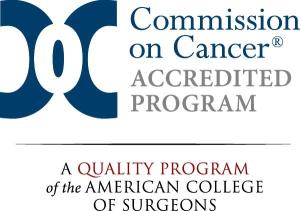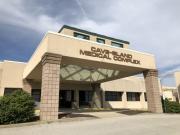Head and Neck Cancer
Head and neck cancer can be complicated. But as an accredited Comprehensive Community Cancer Program, we offer nearly all the same options and technology you’d find at an academic medical center, just close to home.

We’ll work with you, and with one another, to develop a treatment plan that’s personalized to your unique diagnosis, needs and treatment goals. And our multidisciplinary team of cancer doctors and supportive care clinicians will treat your cancer holistically, caring not just for your physical health, but your mental and emotional health, too.
What is Head and Neck Cancer?
Head and neck cancer is cancer that develops in the mouth, lips, throat, nose, salivary glands or other areas of the head and neck. The biggest risk factor for head and neck cancer is tobacco use, but risk increases even more for people who use both tobacco and alcohol.
Risk Factors, Symptoms and Treatment Options
Although tobacco use (and tobacco and alcohol use combined) is the biggest risk factor for head and neck cancers, there are other risk factors depending on the type. In most cases, head and neck cancers are found because of the problems they cause, such as trouble eating or swallowing, for example.
A head and neck cancer diagnosis requires expert care from a multidisciplinary team. That’s why your care team may include a variety of specialists, such as medical, radiation and surgical oncologists and an otolaryngologist. It also may include supportive care clinicians, such as dietitians, genetic counselors and nurse practitioners.
Treatment for head and neck cancer typically depends on where it develops.
Laryngeal and Hypopharyngeal Cancer
Cancers that start in the larynx, or voice box, are called laryngeal cancers. Cancers that start in the hypopharynx, or lower throat, are called hypopharyngeal cancers.
Risk Factors
- Age, with most diagnosed in people 65 or older
- Gender, with these types of cancers affecting men five times more often than women
- Genetic syndromes, like Fanconi anemia and dyskeratosis congenita
- Human papillomavirus (HPV) infection
- Obesity
- Poor nutrition
- Workplace exposure to harmful substances, like wood dust, paint fumes and other chemicals
Symptoms
- Ongoing hoarseness
- Pain and trouble breathing
- Voice changes that don’t get better or worsen
Treatments
For laryngeal and hypopharyngeal cancers, we most commonly recommend surgery, which is typically performed to remove the cancer and some of the normal tissue surrounding it. We also may remove lymph nodes during the surgery. If cancer has spread, we may recommend combining surgery with other treatments, such as chemotherapy or radiation.
We also may perform reconstructive surgery to help restore the appearance and function of the throat after surgery. That may include microsurgical techniques involving tissue grafting, which moves tissue from a healthy part of the body to the area that’s being reconstructed.
In addition, we may treat some advanced laryngeal and hypopharyngeal cancers with targeted therapy drugs designed to interfere with EGFR (epidermal growth factor receptor), a protein that helps cancer cells grow. Or we may prescribe an immunotherapy drug that targets certain checkpoints, or proteins, on immune cells to trigger an immune response.
Oral Cavity and Oropharyngeal Cancer
These head and neck cancers start in the mouth or throat. Specifically, oral cavity cancer (also called oral cancer) starts in the mouth, and oropharyngeal (throat) cancer starts in the middle part of the throat just behind the oral cavity. This part of the throat includes the base of the tongue, the soft palate (the back part of the roof of the mouth), the tonsils, and the side and back walls.
Risk Factors
- Age, with most diagnosed in people 55 or older
- Gender, with these types of cancers affecting men two times more often than women
- Genetic syndromes, like Fanconi anemia and dyskeratosis congenita
- HPV infection
- Obesity
- Poor nutrition
- Ultraviolet (UV) light exposure
Symptoms
- Feeling that something is caught in your throat
- Lumps in the mouth, neck or base of the throat
- Numbness of the lip, tongue or other parts of the mouth
- Pain in the mouth that doesn’t get better or worsens
- Sores on the lips or in the mouth that don’t get better or worsen over time
- Swelling or pain in the jaw
- Thickening in the mouth or on the lips
- Trouble chewing or swallowing
- Trouble moving the jaw or tongue
- Voice changes
- White or red patches on the gums, tongue, tonsils or mouth lining
Treatments
For oral cavity cancers, surgery is often the primary treatment, with radiation therapy or chemotherapy (or the two combined) following. For oropharyngeal cancers, we typically recommend a combination of chemotherapy and radiation. We may also perform reconstructive surgery after the cancer surgery to help with appearance and function.
These cancers also may respond to certain targeted therapy and immunotherapy drugs.
Nasopharyngeal Cancer
Nasopharyngeal cancers begin in the nasopharynx, which is the upper part of the throat behind the nose and near the base of the skull.
Risk Factors
- Age, with risk increasing with age in places where this type of cancer isn’t common and decreasing in places where it is common
- A diet high in salt-cured fish and meats
- Epstein-Barr virus (EBV) infection
- Family history of the disease
- Gender, with these types of cancer affecting men two to three times more often than women
- HPV infection
- Race and geography, with risk most common in Asia
Symptoms
- Blurred or double vision
- Facial numbness or pain
- Frequent nosebleeds
- Hearing loss or ringing in the ear
- Lump or mass in the neck
- Nasal blockage that doesn’t go away
- Recurrent ear infections
- Trouble breathing or talking
Treatments
For nasopharyngeal cancers, surgery is typically not the first treatment because of the cancer’s location. We may recommend it to remove lymph nodes in the neck that don’t respond to other treatments, however.
A combination of radiation and chemotherapy, called chemoradiation, is usually the main treatment for these types of cancer. They also may respond to certain targeted therapy and immunotherapy drugs.
Nasal Cavity and Paranasal Sinus Cancer
These types of cancer develop in or near the nose. Nasal cavity cancers start in the opening behind the nose. Paranasal sinus cancers begin in the air-filled spaces in the skull around or near the nose.
Risk Factors
- Age, with most diagnosed in people 55 or older
- Gender, with these types of cancer affecting men two times more often than women
- Hereditary retinoblastoma treatment, with risk increasing in people who were treated with radiation as children for retinoblastoma
- HPV infection
- Race, with more white people developing these cancer types
- Workplace exposure to harmful substances, like wood and textile dust
Symptoms
- Blockage of one side of the nose
- Bulging of one eye
- Changes in vision
- Constant watery eyes
- Facial numbness or pain
- Frequent nosebleeds
- Hearing loss
- Nasal congestion that doesn’t go away or worsens
- Pain above or below the eyes
- Problems with sense of smell
- Pus that drains from the nose
- Trouble opening the mouth
Treatments
For nasal cavity and paranasal sinus cancers, surgery is generally the first treatment. For tumors that can’t be removed with surgery alone, we may advise adding radiation, either alone or with chemotherapy.
These cancers also may respond to certain targeted therapy and immunotherapy drugs.
Salivary Gland Cancer
Salivary gland cancer starts in one of the salivary glands, which are organs located on either side of the face. This type of cancer is rare compared to other types of head and neck cancer.
Risk Factors
- Age, with risk increasing with age
- Past radiation treatment to the head and neck
Symptoms
- Facial numbness or pain
- Lumps or swelling in the mouth, cheek, jaw or neck
- Pain in the mouth, cheek, jaw or neck that doesn’t go away or worsens
- Trouble opening the mouth
- Trouble swallowing
- Weakness on one side of the face
Treatments
For salivary gland cancers, surgery is most often the first treatment. We may include radiation therapy in your treatment plan after surgery, or as the main treatment if your tumor can’t be removed by surgery because of the location or size of the tumor.
Some salivary gland cancers also may respond to hormone therapy drugs that target the androgen receptor, a protein that helps cancer cells grow, and certain immunotherapy drugs.
Diagnosing Head and Neck Cancer
If your doctor suspects cancer, they’ll likely perform a thorough physical exam to look closely at your head and neck, including your lymph nodes.
Diagnosing this type of cancer sometimes involves looking inside the mouth and throat with either a flexible or stiff tube, such as a laryngoscope, pharyngoscope or nasopharyngoscope that allows us to see abnormal tissue and biopsy (take out) samples if necessary.
It also may involve an incisional biopsy, which is the most common type of biopsy to check for changes in the mouth or throat, or a fine needle aspiration (FNA) biopsy, which is used to find the cause of a swollen lymph node in the neck.
In addition, we use minimally invasive techniques whenever possible, such as interventional endoscopy, in which we guide a scope through the mouth and throat to perform biopsies and surgical procedures. This type of technique helps reduce scarring, infection risk and recovery time. Owensboro Health is one of the only locations in Kentucky to offer interventional endoscopy.






































